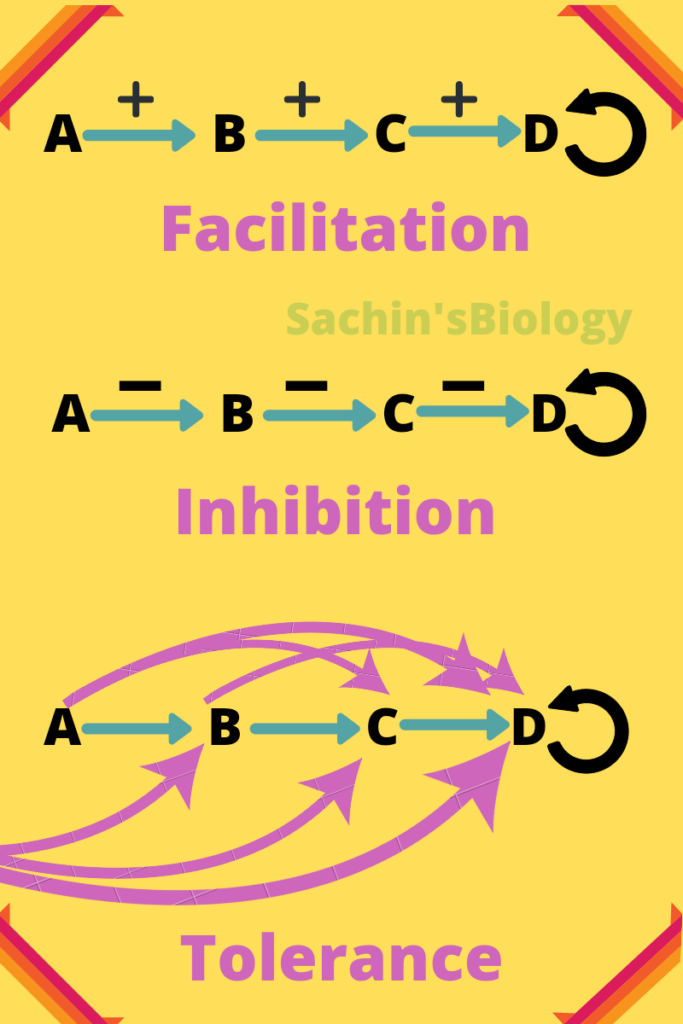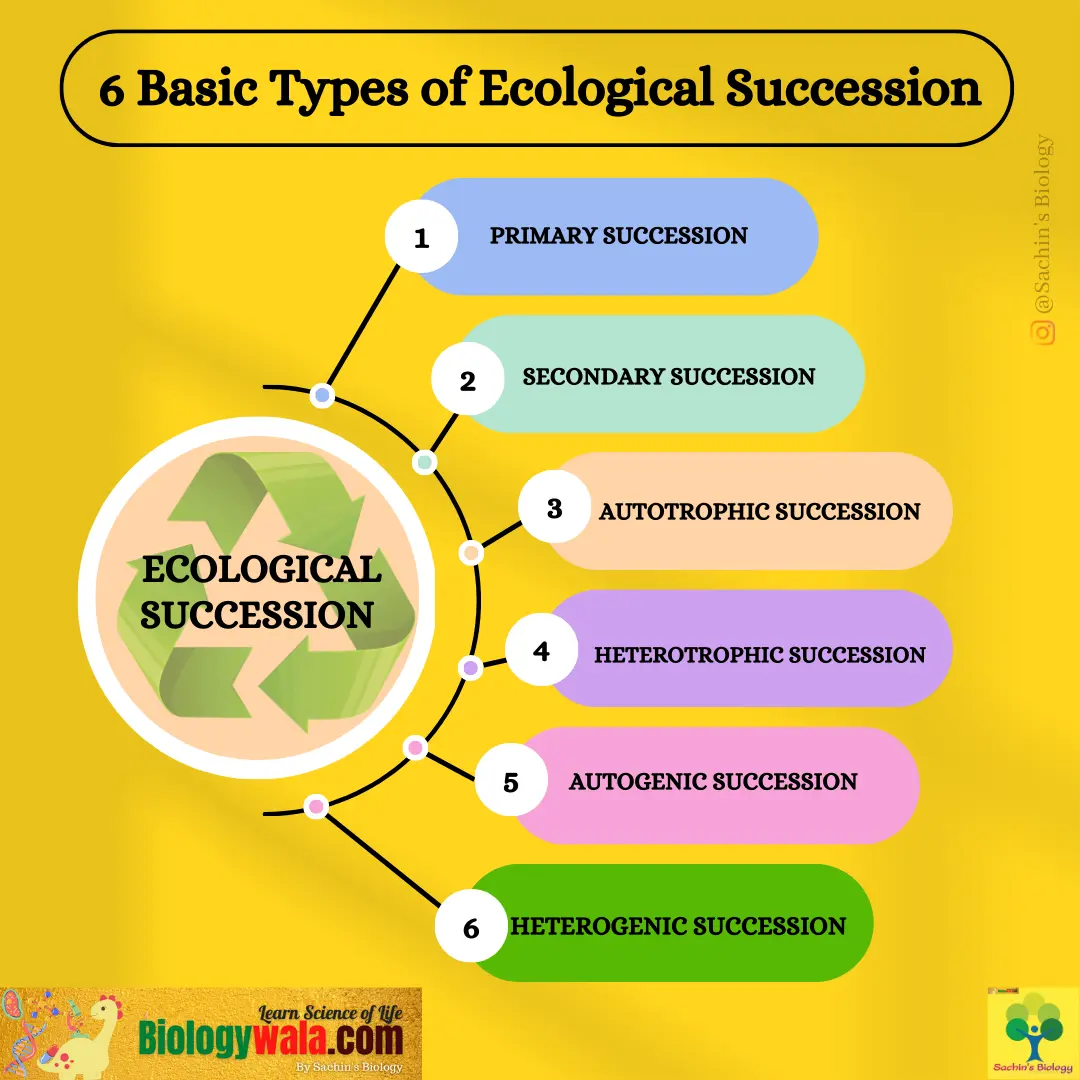Ecological Succession: Types, Mechanisms and Stages

Change is the only constant in the universe and the environment is not an exception so is ecological succession. The environment has been dynamic over the life history of the Earth due to several factors:
- Change in climatic and physiographic factors.
- The activities of individuals in the communities.
These factors bring out specific changes in the dominance of the existing community. Which in turn sooner or later replaced by another community at the same place. This process continues and successive communities develop one after another over the period in the same area until the final community again becomes more or less stable for some time.
Ecological succession definition:
This occurrence of a relatively different sequence of the community over some time in the same area is known as ecological succession. Each phase of ecological succession is called a Sere or seral stage. The initial sere was known as Pioneer seral stage.
While due to disturbance by the community from the later seral stage, it may acquire an earlier seral stage (Like retrograde pathway of Evolution where complex characters get replaced by earlier simpler character) this is relatively rare in occurrence as generally community moves towards the climax.
3 Mechanisms of succession:
Environment modifies itself in specific ways it may make more suitable conditions for later stages, or it may allow other populations to survive with itself or it may resist the invasive organisms to survive with them. Based on all these behaviours of earlier species for upcoming species populations there are three kinds of the mechanism of succession:
- Facilitation mechanisms of succession
- Tolerance mechanisms of succession
- Inhibition mechanisms of succession
I] Facilitation mechanisms of succession
Facilitation is one of the mechanisms of succession where earlier organisms exploit the habitat and act as a Pioneer species. They are most capable of occupying and establishing on the site. Hence this initial species at a given successional stage make the environment more suitable for the lateral successional stage.
Example:
Lepraria (crustose), Pamelia (foliose), and Usnea (fruticose) are lichens that act as Pioneer species and break down rock into soil, also play an important role in symbiotic nitrogen fixation and make the soil more fertile for organisms in the next ecological succession stage.
II] inhibition model of succession:
According to this mechanism species in the existing successional stage (early species) makes the site less suitable for the development of other species. Hence they restrict the invasion of invasive species by making the environment less suitable or harsher for upcoming species.
Example:
Allelopathy: Some plants secrete chemicals to make the soil less suitable for germination and growth of invasive species.
III] Tolerance mechanisms of succession:
Unlike other mechanisms of a succession of this type, all species in the successional stage have the capacity of establishing on a newly disturbed site. The existing organism in the successional stage has very little impact on later successional stages. The existing species won’t oppose (not severely) or even favour the newly invaded species.
Example:
All organisms can start at the same time but due to different life cycles and life histories, they show dominance at different times.

These 3 are the mechanisms of succession, which is responsible for the generation of different types of ecological succession. Following are the different types of ecological succession.
6 basic types of ecological succession:

1) Primary succession:
In this type of succession, the sequence of communities develops in newly exposed habitats with no pre-existing life.
Example: Succession on bare rock and newly deposited sand.
2) Secondary succession:
It is a type of succession where the sequence of communities takes place on sites that have pre-existing life.
Example: Second round of succession on burned areas or clearcut forests.
3) Autotrophic succession:
When most of the organic matter is fixed by autotrophs and mostly the living biomass is in plants then the succession is known as autotrophic succession.
4) Heterotrophic succession :
It is also called degradative succession. Because it is the succession of a degradable source where most living biomass is animal fungal or microbial material.
5) Autogenic succession:
When the environment is modified by species of the community itself such that condition becomes unfavourable for that community and more favourable for upcoming communities is known as autogenic succession.
Example: Autogenic succession can be seen in the facilitation type of succession mechanism.
6) Heterogenic succession:
It is also called allogenic succession. In this case of succession, the pre-existing community is replaced by another community due to external factors and there is no role of internal factors or existing species of a population.
This is it for Mechanisms of succession. There are a few important points need to understand the types of succession:
- Process of ecological succession
- Dynamics in succession: Hydrosere, Xerosere, microsere.
- Climax concept: Mono-climax theory, Polyclimax theory, etc.
We will publish all these important points soon.
If you want to practice questions on ecology and other CSIR NET JRF Life Science Exams then try these test series:
- Ecology Test 1
- Biochemistry Test 1
- Molecular Biology Test 1
- Plant Physiology Test 1
- Developmental biology Test 1
Hope you liked this article about ecological succession: mechanisms and types. If you think there is something in this article or need any kind of improvement you can let us know in the comment box below.
You also like:
Regulation of gene in Prokaryotes
[Download] Free Molecular Biology of Cancer PDF Book 4th Edi.
If you want important notes and updates about exams on your mobile then you can join SACHIN’SBIOLOGY on Instagram or Facebook and can directly talk to the founder of Sachin’s Biology and Author of biologywala.com Mr Sachin Chavan M.Sc. NET JRF (AIR 21) GATE!



Well informed
Thank you Yachika for your words !!
thank you Yachika !!!